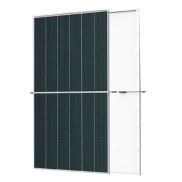HJT Solar Panels vs. Traditional Monocrystalline Silicon Panels : Manufacturing Costs
Time of Release : 2024-04-16
In the dynamic landscape of solar energy, the quest for more efficient and cost-effective photovoltaic technologies has led to the emergence of innovative solar panel types. One such technology, HJT (Heterojunction Technology), has garnered attention for its potential to deliver higher efficiency and performance compared to traditional monocrystalline silicon panels. A critical consideration in evaluating the feasibility and adoption of HJT solar panels is their manufacturing costs. In this article, we delve into a detailed comparison of the manufacturing costs of HJT solar panels versus traditional monocrystalline silicon panels.

Traditional Monocrystalline Silicon Panels
Monocrystalline silicon panels have been the cornerstone of the solar industry for decades, prized for their reliability and established performance. The manufacturing process for monocrystalline silicon panels involves growing a single crystal structure from a silicon melt, resulting in high-quality solar cells. While these panels offer proven efficiency and durability, advancements in technology have spurred the development of alternatives that promise higher efficiency and potentially lower manufacturing costs.
HJT Solar Panels: Efficiency and Innovation
HJT solar panels represent a fusion of crystalline silicon technology with thin-film technology, aiming to achieve superior efficiency levels. The manufacturing process of HJT panels involves depositing thin layers of amorphous silicon on both sides of a crystalline silicon wafer, creating a heterojunction. This innovative approach reduces the amount of silicon material required while enhancing light absorption and electron transport, potentially leading to higher efficiency and cost savings.

Key Factors Affecting Manufacturing Costs of HJT Panels:
1. Material Efficiency: HJT technology utilizes thin-film deposition techniques, allowing for the use of less silicon material compared to traditional monocrystalline silicon panels. This reduction in material usage can result in significant cost savings during manufacturing.
2. Production Efficiency: Efficient manufacturing processes, automation, and economies of scale play crucial roles in reducing labor costs and increasing production output, thereby impacting the overall manufacturing costs of HJT panels.
3. Equipment and Technology: Investments in advanced equipment and technology for thin-film deposition and cell processing are essential for achieving high-quality HJT panels. While initial investments may be higher, advancements in manufacturing techniques can lead to cost reductions over time.
Comparative Analysis
When comparing the manufacturing costs of HJT solar panels to traditional monocrystalline silicon panels, several factors come into play. While HJT technology may entail higher initial setup costs due to the need for specialized equipment and processes, the potential for cost savings through material efficiency and increased energy production efficiency can make it competitive in the long run.
Cost Efficiency: The use of thin-film technology in HJT panels allows for the optimization of material usage, potentially resulting in lower manufacturing costs per unit of power output compared to traditional monocrystalline silicon panels.
Efficiency Gains: HJT technology offers the promise of higher efficiency levels, which can translate to increased energy production and financial returns over the lifespan of the panels, offsetting the initial manufacturing costs.
Innovation and Research: Continued research and development in HJT technology are crucial for driving further cost reductions and performance improvements, ensuring its competitiveness in the solar energy market.
In conclusion, the manufacturing costs of HJT solar panels compared to traditional monocrystalline silicon panels are influenced by various factors such as material efficiency, production processes, and technological advancements. While initial costs may vary, the potential for higher efficiency and cost savings in the long term positions HJT technology as a promising contender in the solar energy landscape.
Embracing innovation and investing in advanced solar panel technologies like HJT is essential for driving the transition towards a sustainable and renewable energy future. By understanding the nuances of manufacturing costs and efficiency gains associated with different solar panel technologies, stakeholders in the solar energy industry can make informed decisions to accelerate the adoption of clean energy solutions worldwide.




